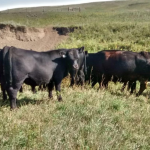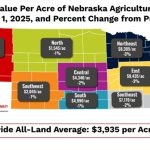Derecho delivers tough blow to farming operations
For Tri-State Livestock News
For people across eastern South Dakota and Minnesota, the May 12 storm that lasted 20 to 30 minutes with a wall of wind and debris turned their worlds upside down.
Near Colton, South Dakota, 61-year-old Wendy Lape of Wentworth was driving with her husband when the storm hit. A chunk of wood came through a window of their vehicle and struck Lape. She was taken to a hospital, where she later died from her injuries.
In Sioux Falls, Annie Lanning, a 43-year-old teacher, was killed when a tree fell on her car during the storm.
Near Blomkest, Minnesota, a grain bin fell onto a car during the storm and killed 63-year-old Ryan Erickson from Lake Lillian, Minnesota, who was a passenger in the car.
With the straight-line winds hurling debris at nearly 100 mph, Drew Peterson is amazed there weren’t more injuries and fatalities. “We are so sorry for the deaths that occurred. There were many people caught in tractors, in trucks, on 4-wheelers and in Rangers that could have been hurt badly.”
Near Salem, South Dakota, Peterson thought he still had time to move his planter and sprayer home. Seeing the roiling dust cloud coming at him changed his focus as he found the closest shelter in one of the farm sheds.
He and a couple of his neighbors huddled in the bathroom where they could hear the shed being torn apart in the storm. “We could hear the wind ripping the walls and rafters apart. The feed truck was in the corner close to us. I believe that solid-built truck saved us as it was holding up the roof section. After the winds stopped, my thought was, ‘I am lucky to be alive.'”
“When we walked out of the shed, the first thing we saw was cattle everywhere,” Drew said. “The calving barn and our houses are all that are left intact.”
When you have 950 cows with lots of pairs, what do you do? You take care of them.
“We had three groups with 400 pairs total that got out and mixed that we rounded up. We pushed them into a summer pasture. Since it was close to sunset, we let them graze overnight. At 10 the next morning, we had 15 to 18 people out there to help. Anyone who has ever moved that many young calves knows it takes a lot of work to keep the calves from bolting and getting separated.”
The others were in five other pastures with fences that needed some fixing, but they were able to stay there.
It was fortunate that the calving structure didn’t collapse as there were still about 100 cows housed there. “Probably five animals were killed by the flying debris. We think we were pretty lucky. We’ve treated some calves with some injuries and are watching closely to see if any health problems develop.”
Priorities have adjusted as the family figures out what needs to get done. “Our normal date for moving pairs to pasture is right around May 15. That’s when we brand. With the events of last week, we are concentrating on getting seed in the ground and will work with the cattle as we have time.”
A sturdy pipe fence surrounds the feedlot, so those animals didn’t get out, but they had to be fed. Drew said it took two days to figure out how to get the feed truck unburied. They used a telehandler and two payloaders to ease the truck from the debris. It has some cosmetic damage, but it runs. “We are so very lucky that a rafter wasn’t driven through the radiator.”
Drew said the speed of the storm was unreal. “We thought we’d have 30 to 40 minutes before the storm hit. We’d planned to drive 10 miles to bring the planter and sprayer home but ran out of time. It was a blessing, as the equipment left in the field was undamaged.”
While warnings of the storm popped up on his phone, “We were busy farming and getting stuff done. We were in the field planting and spraying. Maybe if I knew the storm had the potential to be a derecho, with 70 to 100 mph winds, I would have gone to my dad’s basement earlier.”
With 4,000 acres to cover, it was important the Drew get back spraying fields Sunday and planting corn Monday. They are about half done with getting the crop planted.
“If this had been a tornado with some places getting hit, we’d all join to help our neighbors. But the whole community, the town got hit, everyone’s farm got hit. We each had huge messes to take care of. We are so thankful that people from outside came to help.”
Drew is waiting for insurance adjusters to visit the farm. “We don’t know what our financial position will be until we hear from them.”
Drew guesses that hundreds to thousands of grain bins have been destroyed. Maybe 20 percent of the bins remain, which will be a big problem in the fall when grain comes off the fields.
When asked how he manages the losses mentally, Drew said he prioritized what needs to get done and does it. “South Dakotans are good at getting things done, at making things work. That’s what we do. We can’t do it without the support of people who care enough to drop everything in their lives to help us through this. We had hundreds of acres covered by debris. People spent two days picking that up so we could get back to planting. We couldn’t do that on our own. We can never repay them for their generosity with their time and the care they have given us.”
He emphasized that farmers and their families need to realize they can only do so much, and they must take care of themselves. Ask for help and talk it out. There are going to be bad moments when people are sad or angry about the situation. Some will rebuild and others can’t. People need to know that they don’t have be alone. Reach out to people they trust to talk it out. They can also get help by calling 2-2-1 or the Farm and Rural Stress Hotline at 1-800-691-4336.
“Farmers support each other. On that front, it is mental health awareness month. It’s easy to get frustrated with all the things that need to get done. I encourage people to reach out to those resources to help in coping.”
Roof falls in on milking parlor
Milking stopped abruptly at the Hammink Dairy near Bruce, South Dakota, when the massive storm roared through May 12. Wim and Nicolien Hammink and their son Tom are the owners of the 4,000-cow dairy.
The fast-moving derecho storm brought the roof down on the 72- by 240-foot rotary parlor building and holding area in the middle of milking. As the storm swept through, employees huddled in a pit in the floor in the building. After the storm ended, they and the Hammink family did all they could to move the 60 cows from the carousel and put the system in order.
On a normal day, they milk cows two and a half times. With milking disrupted around 5:30 p.m., the parlor was up and running again about 4 a.m. through the efforts of many. With their full udders, the cows were hesitant to enter and initially had to be pushed into the stalls. It was an enormous relief to get the system working again.
“Big cranes lifted out the debris,” Nicolien said. “The first few days we milked, we ran the milk down the drain. We ordered rafters and steel Saturday and that arrived this week. It’s kind of a miracle to get the supplies so quickly.”
“So many people came out to help and our workers stayed extra to clean up. I get really emotional as I think about all they did. The blown-in insulation was all over and hard to clean. But within those few hours, they had everything working. A generator provided electricity to keep the milk cold so that wasn’t lost.”
Besides the milking parlor, all but 20 of the 300 calf hutches blew away. The wind tossed the baby calves about, and some hutches ended up seven miles northeast of the dairy. By 9 p.m. the next day, Nicolien said they found all but six calves. Of the ones rescued, about eight had to be euthanized by the veterinarian because of their injuries. About 130 of the calves were trucked to Kansas to be raised down there.
Nicolien’s husband Wim was injecting manure into a field and their son Tom planned to pick him up to get to the house ahead of the storm. Instead, Wim sat through the storm in his tractor, fearing that the storm would rip the doors off and smash the glass. He was scared, but he was okay.
When the storm hit, “I stood in the kitchen with the dogs,” Nicolien said. “I saw the hutches fly by our windows and I worried about my two guys in the field.”
With construction going on and as a reaction to the changes, milk production is down for now. Cows are now only milked twice a day. The cows know something is different and they are not producing as much.
Other dairies were affected as well. Global Dairy, at Estelline, didn’t have electricity. They took their 1,700 cows to Milbank, where there was a vacant dairy parlor where the cows could be milked.
It will be a long road to recovery but luckily no one was hurt, and the cows all survived with minimal injuries.
“When you think of all those people who came to help, it is hard to express our gratitude,” Nicolien said. “I wanted to offer food to the 50 people who were helping, but with electricity out in Estelline and Brookings, I couldn’t even offer that as a thank you. But I think in the future, I will be quicker to reach out to my neighbors to offer help when they need it.”
Madison farmer sees importance of staying positive
In Lake County, maybe 80 percent of the farms suffered damage in some way from the derecho. People lost barns, shops, machine sheds, and lots of trees. It didn’t seem to matter which way the buildings faced when the storm took them down.
John Morse of Madison knew the storm was coming and scurried to get everything tucked away. “When the storm hit, I was frantically trying to get equipment into the shop and to get the door closed. It went from a bright day to pitch dark. It was quite scary, and I was shocked at how fast it came. Within 20 to 30 minutes, it blew out.”
“This was more frightening than in 1993 when I faced down a tornado,” Morse said. “I knew weather was rolling in then. At that time, I took cover in a calving barn, which wasn’t my brightest move. I had little choice. I looked out and saw a tornado about 200 yards from where I stood. The intensity of this storm was greater — it was unreal.”
As far as the storm dampening spirits, Morse said, “Those of us who are in farming are pretty bummed out, but it’s hard to be totally depressed. We know there are risks. We had the potential to get the crop in. There is moisture in the ground after an extremely dry winter in this part of the state. Commodity prices are excellent and most of us were pretty optimistic that we’d have a decent year even with high inputs and inflation.”
In his 29th year of farming, Morse reflected. “I’ve had setbacks, battled water, drought and other adversities. I’ve found the best thing is to keep a level head. Some things are out of our control. It’s important to keep moving forward. If you are still farming these days, you must accept adversity and come up with plans to make it work in the future. We have to be supportive of others. We have crops to plant, cows to get to grass. There isn’t time for self-pity.”
“Cattle that were contained with electric fences learned quickly that the electricity was off.” He has a herd of about 250 cow-calf pairs. “They always want to get to the greener grass on the other side of the fence.”
Because electricity was out for an extended period, some installed battery or solar powered fence chargers. Morse was without power from Thursday night until Saturday night. For others, it was a longer wait as power poles and lines were snapped by the fierce storm. Tarps cover roofs where winds ripped shingles from houses, waiting for future repairs.
“I’ve not heard of anyone who lost cattle. Most of the herds were up and on the move. They sensed the storm coming,” he said. “Once we got them rounded up and back in fences, they settled down. They are resilient and creatures of habit. Once they got feed in them, they were calm.”
The damage is hard to fathom. For one neighbor, damage in the yard was extensive but a few hundred yards away, grain bins stood untouched. “At the Farmers Ag Center in Madison, many windows were smashed in sprayers, spreaders, semis and delivery trucks. One of the fertilizer spreaders was okay, but the globe for GPS was smashed, so that machine is unusable until that is replaced. There just is a lot of damage,” Morse said.
Farmers are under the gun to get crops planted. Broken limbs from shelterbelt trees litter most fields. Those areas have to be patrolled for debris before planters can roll.
It will be hard to get grain bins replaced or repaired before harvest. Morse guesses that eight or nine people had major damage to their 200,000-plus bushel grain setups. Many are making contingency plans. But the emphasis now is to get the corn in the ground and get the work done. By harvest, “We’ll have it figured out,” he said.
After the storm, it was difficult to know where to start. “We have a cow-calf operation, so we had to get the chores done. It’s too early for the animals to go to grass so we must feed them every day. We make the best choices about what to tackle and move forward.”
In a situation like this, damage is so widespread that many are concentrating on cleanup with help from family, because the neighbors have their own cleanup to do. “In 1993 with the destruction from the tornado, neighbors who weren’t affected would divide up the work and help those in need,” Morse said. “With this storm affecting about 80 percent of the county, it makes it hard to leave your operation to help others. We offer support when we can.”
“The disruption caused by this storm was frustrating,” he said. “But my folks taught me to stay positive and move forward. I hope the rains keep coming, the sun keeps shining. Harvest may offer some challenges. But as farmers and ranchers, we have great opportunities.”
Matthew Dux, meteorologist at the National Weather Service in Sioux Falls, said they labeled the May 12 storms that moved through the area as a “derecho.” By definition, a derecho is a long-lasting storm system capable of producing extreme winds and damage over an extended area of space and time.
The storm, with winds 70 to 80 mph, moved through a wide swath of southeast/eastern South Dakota. Winds were intense for 20 to 30 minutes, resulting in a great deal of damage in cities, on farms, and in rural areas. The highest wind gusts were 107-mph recorded at Tripp, South Dakota; a 97-mph wind gust in Madison, South Dakota, and a 90-mph wind gust in Huron, South Dakota.
Dux said, “It’s very rare to have such straight-line winds. This is about the same as a category 1 hurricane (74 to 95 mph) and an EF0 to EF1 tornado (65 to 110 mph) over a large area.”
The storm started near the Kansas border, expanded while crossing Nebraska and stretched about 130 miles wide from Chamberlain to east of Sioux Falls. It angled to the northeast, exiting the state around Browns Valley. Total track was 400 to 500 miles.
Preceding the derecho in the southern part of the state was an enormous wall of dirt and debris called a haboob. A haboob pushes out along the ground from a thunderstorm downdraft at high speeds, according to NOAA. Haboobs can occur anywhere in the United States, Dux said, but they are most common in the Southwest.
Dux said this resulted from little vegetation on the agricultural ground at this time of year. Delays in planting left a lot of dirt that could be swept into the cloud. If the same storm came through in a few months, there would not be the cloud of dust.
Later that evening, another line of thunderstorms developed in eastern Nebraska and entered extreme eastern South Dakota. While weaker, these storms continued to produce wind gusts between 50 and 87 mph.
“It was a rare event. Atmospheric conditions needed to be in alignment for this to happen. Last summer, a similar storm devastated Iowa. We’ve not seen ones with this high of intensity for quite a while. We don’t know if it will happen again.”
Several tornadoes were confirmed. Some of the worst damage occurred in Hamlin and Deuel counties. An EF2 tornado, with wind speeds up to 120 mph, passed through the town of Castlewood, South Dakota. A tornado also devastated another farmstead south of Gary, South Dakota. At this location, they estimated wind speeds at 135 mph, which ranks it as a high-end EF2 tornado.
Power outages
Power was out for thousands of people as power lines were damaged and poles snapped. Sioux Valley Energy serves over 23,000 homes, farms and businesses with electric service in east-central South Dakota.
On the website of Sioux Valley Energy, they posted: “We’ve never fought storm conditions like this before. We’re basically dealing with a damage path 50 miles wide and 100 miles long,” said Sioux Valley Electric vice president of engineering and operations, Ted Smith. Swath of damage caused by the derecho is more widespread than ice storms or tornadoes, which have a more focused area of damage.
SVE engineers continue to patrol the co-op’s 6,100 miles of line—the equivalent of driving from Los Angeles to Boston, and back again. Besides SVE’s workforce of 100-plus employees, over 60 personnel from other co-ops and contractors are working to get power back to everyone as soon as possible.















